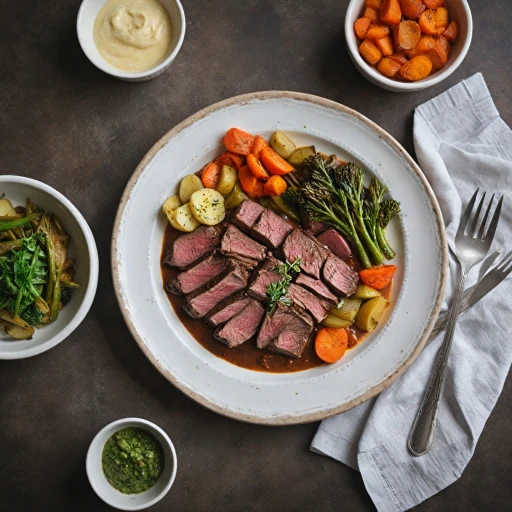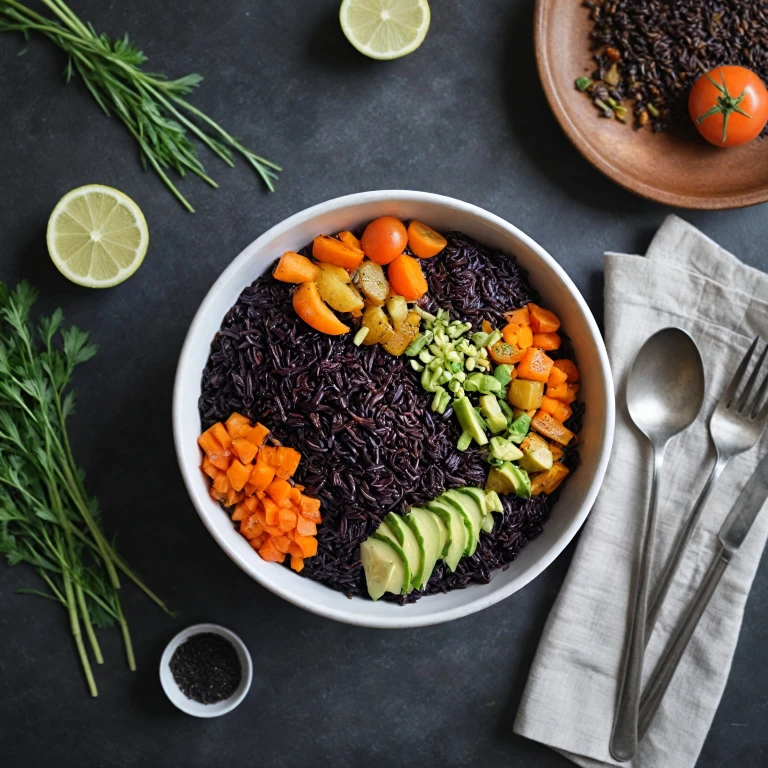Understanding Black Rice
Exploring the Essence of Black Rice
Black rice, often recognized as "forbidden rice," has a rich history and is renowned for its unique nutritional profile. Unlike the more common white rice, black rice is packed with antioxidants, particularly anthocyanins, which give it a distinctive dark hue. This nutrient-packed grain is said to have been reserved for Chinese royalty in ancient times due to its superior health benefits and rarity.
The allure of black rice lies not only in its striking color but also in its remarkable texture. When cooked, it offers a chewy yet tender experience that is different from that of white rice or brown rice. The flavor is slightly nutty, making it an excellent choice for a variety of recipes, ranging from exotic main courses to unique side dishes.
Water absorption is key when cooking black rice, and it is vital to account for the right ratio of water to rice for optimal results. Enhanced by the versatile capabilities of an instant pot, you can harness the power of a pressure cooker to achieve perfectly cooked black rice in a fraction of the traditional cooking time.
Cooking black rice in an instant pot not only simplifies the process but also enhances the rice's natural flavor, encouraging you to explore diverse culinary creations. While the overarching process is straightforward, attention to detail such as correct rinsing and monitoring release techniques can greatly influence the final outcome.
For those interested in culinary exploration beyond typical rice recipe routines, mastering black rice with the help of modern kitchen technology like the instant pot is a rewarding endeavor. If you're eager to dive into the world of instant pot recipes, you might also enjoy reading more about
cooking bratwurst using this versatile appliance.
Why Use an Instant Pot for Black Rice?
The Power of Instant Pot: Unlocking the Full Potential for Black Rice
Cooking black rice, also known as forbidden rice, comes with its unique set of challenges that the Instant Pot can help surmount with precision and ease. Embracing this versatile kitchen companion not only streamlines the cooking process but also enhances the nutritional profile of your meals.
- Efficient Cooking Time: Traditional cooking methods for black rice require longer time minutes compared to its white or even brown rice counterparts. With the Instant Pot, the high pressure setting significantly reduces cooking time, making it a time-efficient choice for busy cooks.
- Consistent Results: An Instant Pot delivers consistent temperature, crucial for achieving that perfect texture where each grain is distinct yet tender. Unlike a regular pot, it minimizes the risk of undercooked or unevenly cooked rice.
- Nutrient Retention: Pressure cooking under high pressure helps in preserving the essential nutrients found in this nutrient-rich grain. Black rice, or wild rice, is celebrated for its antioxidant properties, which are better retained when cooked under these conditions.
- Easy Pressure Release: The Instant Pot offers options for natural or quick pressure release, giving you greater control over the cooking process. This flexibility is key to customizing the final texture of your black rice dish.
When chosen for cooking forbidden rice, the Instant Pot takes the guesswork out of gauging the right amount of water or adjusting time minutes like a traditional rice cooker or pot might entail. For an exploration of how an Instant Pot elevates other rice dishes, embark on a
flavorful journey with your pressure cooker.
The allure of the Instant Pot lies not just in turning arduous recipes into quick meals but in its ability to elevate flavors and bring out the best in ingredients. In your quest of cooking the perfect pot black or rice instant recipe, consider it your steadfast kitchen ally.
Step-by-Step Guide to Cooking Black Rice in an Instant Pot
Preparing Your Ingredients
Before you start cooking, make sure you have all the necessary ingredients for your recipe at hand. You'll need one cup of black rice, also known as forbidden rice, and one and a half cups of water. Ensure your instant pot's inner pot is in place, and you're ready to get started. Remember, with pot rice, preparation is key to achieving the perfect texture.
Setting Up Your Instant Pot
To begin, add the black rice and water into the inner pot of your pressure cooker. Ensure that the mixture is evenly spread across the bottom of the pot. Secure the lid, and make sure the pressure release valve is set to the sealing position.
Cooking Time and Pressure Level
Set your instant pot to the manual setting for high pressure cooking. The cooking time for black rice will be around 18 minutes. This differs from white rice, which typically requires a shorter cook time. The high pressure will ensure that your black rice cooks thoroughly and absorbs all the rice water for optimal tenderness and flavor.
Natural Pressure Release
Once the cooking time is complete, allow your pot to sit and naturally release the pressure. This usually takes about 10 minutes mins. Natural release helps to maintain the rice's texture, avoiding the mushiness often associated with quick releases. Be patient, and you'll be rewarded with perfectly cooked black rice.
Troubleshooting Common Issues
If your rice is undercooked or too watery, don't worry – adjustments can be made. Simply return the pot to the sealing position and set the cooker for an additional few minutes. For any excess water post-cooking, draining or letting it evaporate on the sauté setting can help. For more tips on achieving perfect pot rice, check our guide on
mastering Spanish rice in an instant pot.
Common Mistakes and How to Avoid Them
Identifying Common Mistakes in the Black Rice Recipe
When cooking black rice in an instant pot, a frequent oversight is not washing the rice thoroughly. Black rice, like its white and brown counterparts, benefits from a good rinse to remove excess starch, ensuring a non-sticky finish. Remember to use cool running water for this step.
Avoiding Overcooking or Undercooking
Many might set an incorrect cooking time, leading to undercooked or mushy rice. Black rice requires you to set the pressure cooker to high pressure for about 22 to 25 minutes. This range allows the grains to soften properly without losing their unique texture. Make sure to adjust time based on your specific preference and the quality of the rice.
Managing Pressure Release
A common misstep involves mishandling the pressure release. For black rice, after cooking, it's essential to allow for a natural release of pressure for about 10 minutes before opening the pot. Forced release can sometimes lead to breaking the grains or inconsistent texture.
Getting the Water to Rice Ratio Right
Misjudging the water to rice ratio is another common error. For every cup of black rice, use about 1.5 to 2 cups of water. The precise quantity can vary depending on how moist or firm you prefer the rice, but this range serves as a reliable guide for most recipes.
Avoiding an Overfilled Inner Pot
Ensure not to overfill the instant pot as the black rice expands during cooking, requiring space. Stick to the recommended fill line suggested by your pressure cooker’s manual. This step prevents spillage and ensures even cooking.
Enhancing Your Black Rice Dish
Add Flavor and Texture Enhancements
To bring your black rice dishes to life, it's important to think beyond the basics. Here are some tips to enhance your cooked black rice dish with your Instant Pot:
- Herbs and Spices: Incorporate herbs like thyme or spices such as cumin to infuse black rice with aromatic flavors during cooking.
- Broth Instead of Water: Using chicken, vegetable, or beef broth in place of water can significantly enhance the depth of flavor in your pot black rice.
- Sauté Option: Before pressure cooking, use the sauté function to lightly toast the rice or sauté onions and garlic in the Instant Pot's inner pot to add a savory base.
- Adding Citrus: A squeeze of lime or lemon juice after cooking can add a delightful brightness that accents the nuttiness of black rice.
Explore Creative Pairings
Black rice, sometimes called "forbidden rice," pairs well with a variety of dishes. Consider these combinations:
- Colorful Veggies: Mix in lightly steamed or roasted vegetables like bell peppers, sweet potatoes, or spinach for added color and nutrition.
- Protein Rich Choices: Serve as a side dish alongside grilled or roasted chicken, tofu, or fish to make a balanced meal.
- Exotic Toppings: Use nuts, dried fruits, or seeds such as sesame for an exotic twist.
Make it a Creative Centerpiece
Black rice doesn't just have to be a side but can stand out as a main feature in your kitchen:
- Rice Bowls: Craft rice bowls topped with an array of veggies, proteins, and sauces for a wholesome meal.
- Specialty Recipes: Use it in recipes for stuffed peppers or cabbage rolls, where the rice holds up well to additional cooking time.
Enhancing your black rice dish with these suggestions not only heightens its natural flavors but also transforms it into a culinary experience worthy of repeated enjoyment.
Troubleshooting and FAQs
Fine-tuning Your Method: Troubleshooting Common Issues
Cooking black rice in an instant pot can be a rewarding experience, but sometimes things don’t go exactly as planned. Here are some common issues you might encounter and how to solve them:
- Under-cooked or Over-cooked Rice: If your rice is not cooked to perfection, it may be due to an incorrect water-to-rice ratio or inaccurate cooking time. Ensure you're using the right ratio, usually 1 cup of black rice to 1 3/4 cups of rice water. Check your pressure cooker settings to optimize the cooking process.
- Bland Flavor: Sometimes, black rice can lack flavor despite following the recipe. Consider enhancing the dish by adding a pinch of salt or a flavorful broth instead of water during cooking.
- Buildup of Steam: Some users report excess steam escaping from their cooker. Ensure your lid is sealed properly and that the pressure release valve is set to the correct position for high pressure.
- Sticky or Clumpy Rice: If your rice isn’t coming out fluffy, make sure to rinse the rice thoroughly to remove excess starch—this can prevent stickiness and clumps.
- Unexpected Pressure Release: Allow the cooker to naturally release pressure for at least 10 minutes before a quick release to avoid any mess or undercooking. This often solves issues with unevenly cooked rice.
If you frequently experience any of these issues, it may be beneficial to revisit the earlier sections of this tutorial to refine your technique. With these solutions in mind, you can confidently prepare delicious black rice recipes that are anything but forbidden. Taking time to experiment and adjust will turn your pot rice into a delightful meal, ready to accompany any side dish or main course.

